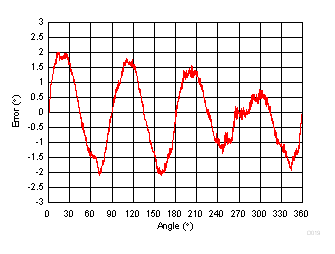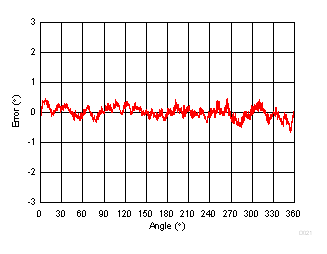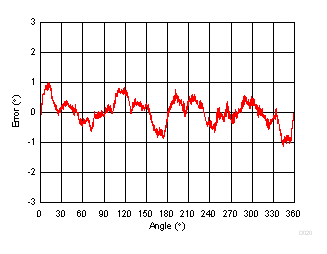SLYA036B July 2018 – November 2021 DRV5053 , DRV5053-Q1 , DRV5055 , DRV5055-Q1 , DRV5056 , DRV5056-Q1 , DRV5057 , DRV5057-Q1
- Trademarks
- 1Introduction
- 2Overview
- 3Device Descriptions
-
4Methods
- 4.1 Uncalibrated Implementations
- 4.2 Peak Calibrated Implementations
- 4.3 Lookup Table Calibration Implementations
- 4.4 Peak Calibrated Plus Lookup Table Hybrid
- 5References
- 6Revision History
4.4.3.3 Accuracy
The accuracy for this method largely depends on the spacing between the calibration points, and can be estimated using Equation 8.
Figure 4-23, Figure 4-24, and Figure 4-25 each show an example of a possible error curve for this setup with a different number of calibration points.
 Figure 4-23 Two Sensors Peak Calibrated Plus Lookup Table Error, 8 Cal Points, ≈ 4° Peak-to-Peak Error
Figure 4-23 Two Sensors Peak Calibrated Plus Lookup Table Error, 8 Cal Points, ≈ 4° Peak-to-Peak Error Figure 4-25 Two Sensors Peak Calibrated Plus Lookup Table Error, 25 Cal Points, ≈ 1° Peak-to-Peak Error
Figure 4-25 Two Sensors Peak Calibrated Plus Lookup Table Error, 25 Cal Points, ≈ 1° Peak-to-Peak Error Figure 4-24 Two Sensors Peak Calibrated Plus Lookup Table Error, 14 Cal Points, ≈ 2° Peak-to-Peak Error
Figure 4-24 Two Sensors Peak Calibrated Plus Lookup Table Error, 14 Cal Points, ≈ 2° Peak-to-Peak Error